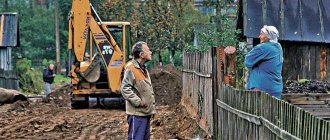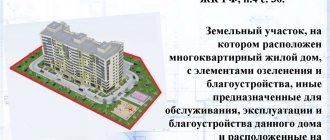In particular, such moments may arise when the cadastral engineer makes mistakes, uses outdated equipment or inaccurate data.
As a result, the documents issued to the owner of the plot contain inaccurate information and data.
Both these and other cases that lead to cadastral errors during land surveying require contacting Rosreestr in order to make the necessary adjustments and bring the documentary data into line with how the border actually runs.
In the event that the application of the owner of the site is made after 30 days from the date of approval of the boundary plan , in most cases, changes can be made through a court decision, for which it is necessary to send a corresponding statement of claim, attaching the required package of documentation.
Documents that are the results of the procedure
In the process of establishing the boundaries of a land plot, the cadastral engineer draws up a boundary file, and the main document included in it is the boundary plan.
Such a plan consists of graphic and text parts and contains a diagram of the location of the site indicating the coordinates of turning points, lines drawn between them, which are boundaries defining the boundaries of the property.
Its text part contains a description of the land plot, containing its main characteristics that are important for determining the cadastral value, the possibility of erecting buildings or structures, cultivating for planting crops and other actions that may take place during the operation of the site.
Based on the drawn up boundary plan, the owner of the plot can apply to register the plot, obtain a cadastral passport, ownership rights, and also make any transactions of a civil law nature that are not prohibited by law .
The legislative framework
Paragraph 3 of Article 14 of the Federal Law No. 218 of 2015 determined that in the case of creating a real estate object (construction of a house) or in the case of putting into operation an already constructed object, simultaneously registered with the cadastral register and registered in the Unified State Register of Real Estate.
In turn, in order to register real estate in the Unified State Register of Real Estate, both a boundary plan (drawn up when surveying the land) and a technical plan (drawn up when surveying a house) are required. Otherwise, Rosreestr simply will not accept documents for registration, since it will not be able to see the specific location of the site and the house.
The requirements for drawing up a boundary plan are regulated by Article 22 of Federal Law No. 218 and Order of the Ministry of Economic Development No. 921 of 2015. Requirements for drawing up a technical plan - Article 24 of Federal Law No. 218 and Order of the Ministry of Economic Development No. 953 of 2015.
Reasons for invalidating results
The law defines the moments and conditions under which the owner of the plot, another person or organization whose rights were affected in the process of land surveying, can count on the admissibility of challenging the results of establishing boundaries.
Thus, such conditions include the following:
- Carrying out land surveying without a boundary approval document signed by all interested parties. The absence of signatures is allowed only if such persons do not appear after the owner of the site has complied with the required notification procedure and there are no written statements from neighbors about disagreement with the boundaries passing in this way;
- Allowance of violations during the execution of work by an engineer. This may be the absence of an operation to go to the site to draw the boundaries in nature, ignoring documentary data on the basis of which the boundary will be drawn in a different way, etc.;
- The emergence of new documentary data or testimony that changes the course of the laid boundary;
- Detection of an error in the provided data . This may be the intersection of the boundaries of adjacent plots, the imposition of one plot on another, the assignment of land to a completely different territory, any other inaccuracies that will occur in the graphic or text part;
- The acquisition of land and its transfer of ownership as a result of squatting of the territory. Such situations occur quite rarely, but can still occur as a result of an inaccurate analysis of the provided documentation by a cadastral engineer or the submission of unreliable data by the customer.
The main two options for redistribution of land plots
- The owners of the plots are individuals or legal entities.
In this case, interested parties need to carry out a set of cadastral works and sign an agreement among themselves on the redistribution of land plots.
- The owners, on the one hand, are an individual/legal entity, and on the other, a municipal entity.
The most common, but also more complex procedure. Includes coordination of the design redistribution scheme with the architecture department of the municipality.
How to cancel results through court
It is possible to cancel the survey results by performing the following steps :
- Contacting the engineer who drew up the existing boundary plan and determined the coordinates of the passing boundaries of the site;
- Collection of documents that may indicate the presence of errors in the drawn up boundary plan;
- Drawing up a statement that reflects the requirement to eliminate the existing error in the boundary plan;
- Providing a package of documentation, a receipt confirming payment of the state fee and the application itself to the cadastral chamber;
- Receive a response within 15 days from the date of application. In most cases, the cadastral chamber refuses to satisfy the person’s request, citing the presence of an existing boundary plan;
- Submitting an appeal to the court. This is done to make it possible to force changes to the drawn up plan based on a court decision;
- Drawing up a claim, providing a completed application with a package of documentation, including confirmation of an attempt at pre-trial settlement along with a receipt for payment of the state fee.
Who has the right to challenge the results?
The possibility of filing appeals to the court to challenge the existing survey results can only take place if the person or organization acting as the plaintiff has grounds.
the following persons have the right to challenge established boundaries in court :
- Persons using the plot or adjacent plots on the basis of a concluded lease agreement;
- Owners of plots who have documentary evidence of ownership of a certain plot of land;
- Persons who own a plot of land with the right to use it indefinitely;
- Persons who own a plot of land on the basis of lifelong inheritable ownership.
Documentation
An appeal to the court in order to be able to challenge the results of land surveying through the court must be accompanied by the preparation and provision of the necessary documentation package in such cases.
The list of documents may differ slightly depending on the specifics of the case under consideration, but it has many common points, among which are :
- A document confirming the right to go to court to challenge the results of establishing boundaries (certificate of ownership, lease agreement, etc.);
- A document confirming the ownership of the person who is filing the claim in court;
- The statement of claim itself, which contains the essence of the issue regarding the established boundaries of the site;
- Land survey plan containing errors;
- A new boundary plan containing the correct information that will need to be entered into the state register.
Contents of the statement of claim
The submitted statement of claim must contain the following information :
- Full name of the applicant, his basic data, information about the site about which there is a dispute;
- Data from the defendant who has a different opinion regarding the boundaries;
- Indication of the essence of the problem - the existing errors in the drawn up boundary plan that need to be eliminated are outlined. In the main part, it is recommended to indicate that the presence of an error violates the existing property right and at the same time does not allow the site to be used to its fullest;
- A reference to laws and other regulations on the basis of which it is possible for the applicant to appeal and declare the boundary plan invalid and requiring amendments;
- Date of completion and signature of the plaintiff.
Hearings
During the trial, the court first considers the submitted documents.
Then it determines whether there are grounds to initiate proceedings.
After this, if all the documents provided do not raise doubts, no additional evidence is required and no challenge is made, a court hearing or public hearing is scheduled.
During the meeting itself, the arguments of both the plaintiff and the defendant are considered , and the overall outcome of the case will largely depend on how complete the list of data set out in the statement of claim is.
When considering an application, testimony of witnesses who are directly related to the case may be heard if the evidence base in the form of documents is insufficient.
If there are counterclaims, they are also accepted for consideration and, if necessary, an examination is scheduled , which is ordered from a geodetic company.
Based on the conclusions of expert surveyors, one can judge how correctly the land surveying was carried out and whether the drawn up plan actually contains erroneous data.
Solution
If there is sufficient evidence, the court may satisfy the application submitted by the plaintiff with a request to recognize the survey results as invalid.
In this case, it becomes possible to re-apply to Rosreestr , where, on the basis of the court decision provided, changes will be made to the data on the land plot, provided that a correctly drawn up boundary plan is attached.
Procedure for redistribution
First, we collect a set of documents. To find out exactly what documents will be needed to redistribute land plots in your particular case, you should contact your local authorities. Article 39.29 of the Land Code states that in order to redistribute land plots, an agreement must be concluded between the owners, for the purpose of which an application is submitted.
Application for redistribution of land plots
The application is standard and easy to fill out. An approximate form can be found on the Internet, but it is better to ask your local authorities what application form is accepted in your municipality, since the application form is not generally accepted. You can also submit an application through government services or by mail.
The application must indicate:
- Full name, address, passport details (for individuals)
- Name and details (for legal entities)
- Cadastral numbers of plots
An integral part of the application will be a package of documents required for redistribution between land plots:
- an extract from the Unified State Register of Real Estate, or copies of documents on ownership or other legal ownership of land
- territory surveying project
- layout of the land plot (if there is no land surveying project)
- extract from the Unified State Register of Legal Entities or Unified State Register of Individual Entrepreneurs (for legal entities).
This is not an exhaustive list of documents. When redistributing land plots that are privately owned or state-owned, some other clarifying documents may be needed, it all depends on the individual case.
Arbitrage practice
During legal proceedings regarding the invalidation of the results of a land survey, there are a large number of cases of judicial practice that had an excellent outcome depending on the completeness of the evidence provided and the testimony heard.
In particular, there are cases of refusal to consider a case, initiate proceedings and invalidate the survey results.
There are cases when the plaintiff’s demands were not satisfied, since upon consideration of the circumstances it was proven that the drawn up plan contained reliable information .
By dispute
The practice of challenging the results of land surveying has the following options for making court decisions :
- Refusal to consider the case due to the fact that the person who sent the application is not the owner or user of the site, and therefore his direct rights were not affected or infringed;
- Refusal to initiate proceedings due to insufficient documents provided, that is, the plaintiff did not provide compelling arguments that the boundary plan contains errors;
- Refusal to consider the submitted application due to the lack of an attempt at pre-trial settlement - an appeal to Rosreestr to make changes to the boundary plan due to errors in the one already drawn up.
Upon recognition of the results as invalid
As a result of consideration of cases to invalidate survey results, in most cases the decision is made in favor of the plaintiff filing an application in the following situations :
- If there is unauthorized occupation of land plots by neighbors, as a result of which the boundaries of the property have been distorted;
- If significant errors were made during the formation of the land allotment and determination of the area of the plot, after which inaccurate data were entered into the state register;
- If, as a result of land surveying, the act of approval of the established boundaries was not signed by all interested parties;
- If the mandatory procedure for notifying owners and users of adjacent areas about the upcoming procedure for drawing out boundaries and their approval has not been followed;
- If reliable data is provided indicating the presence of errors in the boundary plan of the site.
Rules for the formation of land plots in 2021
In accordance with the Land Code (Article 11.2), there are several ways for new land plots to arise. This is how the general rules for the formation of land plots sound in 2021:
- Selecting one, or vice versa, combining several areas
- Redistribution of land plots
- Section (one area is divided into several)
But we will focus on the formation of land plots through redistribution. Let us clarify the procedure and procedure for redistributing land in 2021. We will also find out where to apply and what documents should be collected.
Time limits for consideration of an application for redistribution of land plots
In accordance with Article 39.29 (clause 8) of the Land Code, the period for consideration of an application for redistribution of land plots is 30 working days . This period may be extended to 45 working days if additional documentation or materials are required to review the application. If the application is submitted with violations (there are not enough documents in the package, it is submitted to another authority), then it is returned within 10 days from the date of receipt. Having considered the application for concluding an agreement on land redistribution, the administration makes one of the following decisions:
- Approve the layout plan, or, based on the approved land surveying project, give a positive response to the signing of an agreement on the redistribution of land plots;
- Refuse to conclude an agreement on the redistribution of land plots, indicating legitimate reasons.
If the application is considered and the answer is positive, then the next step will be a Land Redistribution Agreement . An agreement on the redistribution of land plots must be concluded in writing - this is a voluntary desire of the parties with a detailed description of the methods and motives for the redistribution. An agreement is drawn up between interested plot owners. Owners can be private individuals, the state or a municipality.










